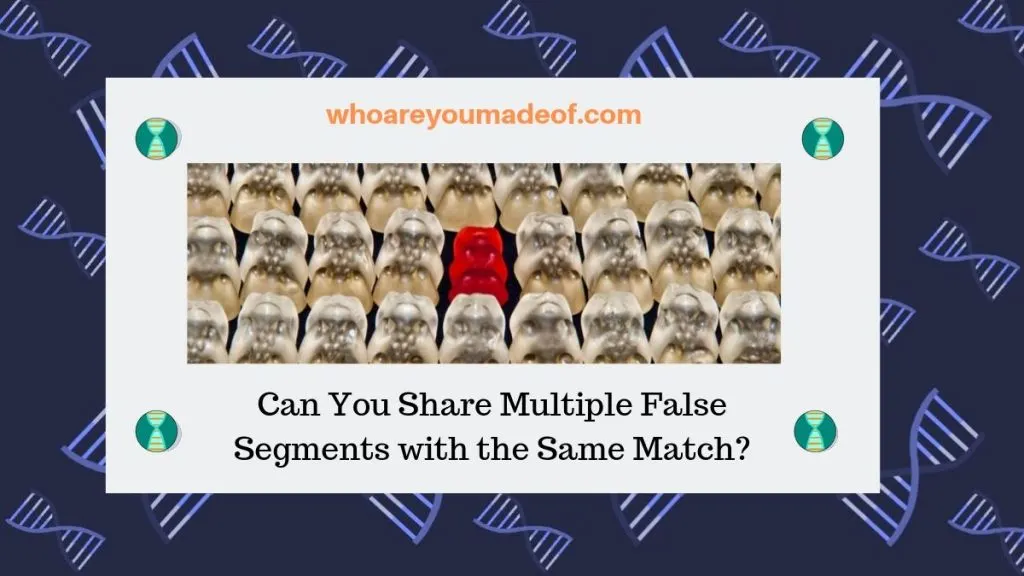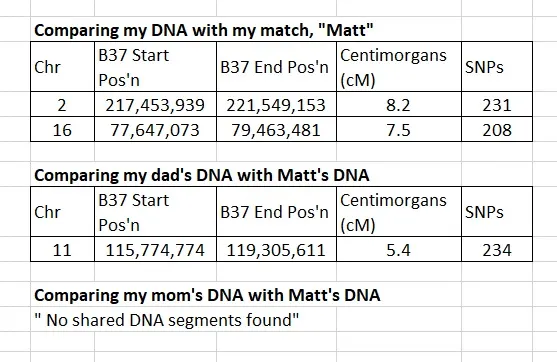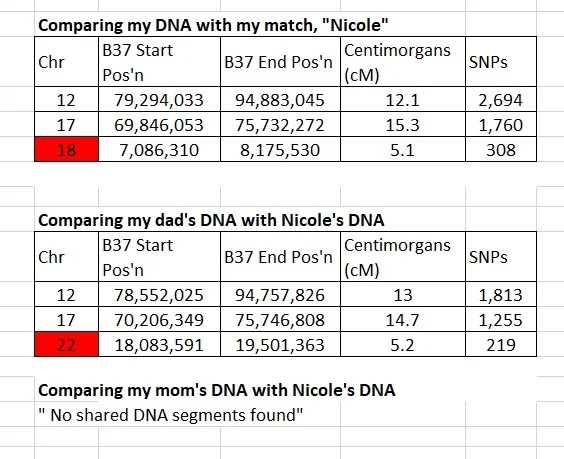You know that some shared DNA segments can be false, but can you share multiple false segments with the same match? In this post, we'll discuss this question using real-life examples.
I've been spending a lot of time lately on the trickier lines of my family tree. For these hard to track ancestors, I only have distant DNA matches with whom I share several smaller segments to work with.

After researching several of these distant matches, I realized that some of our shared DNA segments aren't real. This can distort the total number of shared centimorgans, causing me to think that I am more closely related to my match than I really am.
By eliminating false segments, we can get a better idea of how much DNA we really share with our match, and thus, how we really might be related to each other.
For the purpose of this post, you should be familiar with two important concepts:
- Identical-by-state DNA segments
- Identical-by-descent DNA segments
Identical-by-state DNA segments are segments that are coincidentally the same. Identical-by-state segments, which are most common in segments smaller than 7 centimorgans in length, are often abbreviated using the acronym "IBS".
Identical-by-descent (IBD) DNA segments are segments that are the same because they were inherited from a shared ancestor. IBD segments can occur at any size, but are most commonly seen at lengths longer than 7 centimorgans (cMs).
Is it possible for all shared segments with a DNA match to be false, or IBS?
Yes, it is possible to share multiple identical-by-state (IBS), or false segments with the same match.
It can be quite confusing to chase down a connection to a DNA match when there is actually no genealogical relationship available to find.
To illustrate this, I decided to compare my DNA with one of my DNA matches, who we will call "Matt" on Gedmatch. According to my Gedmatch One-to-One results, Matt and I share two DNA segments of 8.2 and 7.5 cMs in length.
I already know that if Matt and I were related, we would probably be pretty distant cousins. This is because our two shared DNA segments are very small, and a connection, assuming we found one, could be several generations back.
There is one problem, however.
Matt doesn't share any DNA with my mother, and shares an even smaller 5.4 cM segment with my dad that didn't get passed down to me. The image below shows the location and size of our shared DNA segments:

Segments as small as the one shared between my dad and Matt are almost always IBS. The segments that I share with Matt weren't inherited from either of my parents, even though they are longer than the minimum 6-7 centimorgan threshold set by most matching algorithms.
To make sure of this, I checked Matt's DNA against my mom's kit on Gedmatch and there was no match.
The only conclusion I can come to is that Matt and I are not really related, even though we supposedly share enough DNA to show up as distant cousins. If I could not compare Matt's DNA with that of my parents, I could envision myself spending a bit of time trying to identify our distant shared ancestor.
Matt and I just inherited randomly recombined DNA segments from our parents that lined up in such a way that they make us appear to be distantly related when we really aren't. If Matt and I could find a genealogical connection, we don't share any DNA because of it.
Can you share IBS and IBD segments with the same match?
To complicate matters further, it is possible to share both IBS and IBD segments with a match.
For example, take a look at the image below that illustrates my relationship with half-fourth once-removed. The IBS chromosome is highlighted in red.

My dad passed down two shared segments on Chromosome 18 and 22 to me. DNA segments from the same ancestor stay in the same place on the chromosome when they are inherited.
Oddly, I have one very tiny (5.1 cM) shared segment with my match, Nicole, that my dad doesn't have. I checked Nicole's DNA against my mother's, just in case I got it from her - no match.
The only conclusion is that I only have two legitimate shared DNA semgents with Nicole. It's likely that my dad's 5.2 cM match on Chromosome 22 is IBS, too.
How to avoid getting bogged down with IBS segments
Now that you know that both of these scenarios are possible, what should you do? I recommend evaluating each shared DNA segment individually for the likelihood that the segment is IBS or IBD.
There is one little clue that can help us with all of these little shared segments. If the number of SNPs listed in the column to the right is very low, then there is a higher possibility that the segment is a false segment.
If you look back at the image above showing my match with "Nicole", you will see that the valid segments passed down from my parents to me show a total number of between 1700-2600 SNPs. The smaller segments that are false only show a few hundred SNPs.
There is still more that you can do to evaluate these small segments. The following tool can also help you decide where to look (or if you should look) for a family connection with your match.
If both of your parents have taken DNA tests, you can use the phasing utility on Gedmatch to create a kit that eliminates most false DNA segments by only keeping those segments that you share with your parents. A maternal and paternal kit number will be created that you can use for other analysis on the site.
You can read more about phased kits on Gedmatch here:
Alternatively, if you did a DNA test with My Heritage, 23andMe, or Family Tree DNA, you can use the chromosome browser on those sites to ensure that your parent also shares the same segment with a particular match. Of course, this is only useful if your parents have also tested.
Conclusion
I truly hope that this post was interesting to you, and that it helped you understand that it is possible to have multiple false segments with the same match, and that it's also possible to have a combination of false and real segments.
If you have any questions about something that you read in this post, or would like to share your own experience tracking down real and false segments, I would love to hear from you in the discussion below.
Thanks for stopping by today!


D. Reeves
Tuesday 23rd of August 2022
Besides looking for small matches and small amount of snips, what else can you do to find false matches if your parents can't be tested?
Kai Hulkko
Sunday 11th of April 2021
Show me how to Understand DNA woks on me my name is Kai Conrad Hulkko